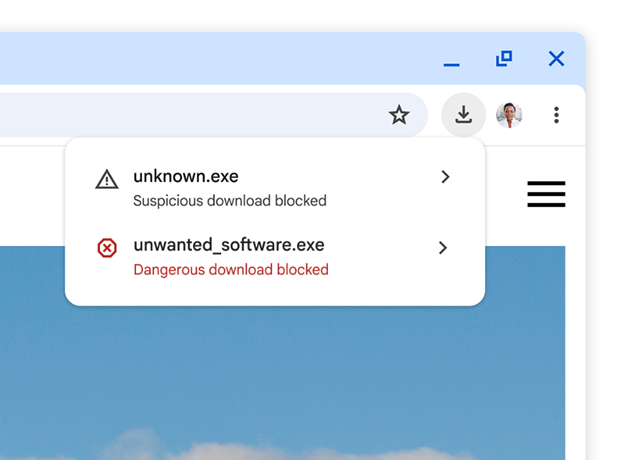Carding Forum
Professional
- Messages
- 2,788
- Reaction score
- 1,223
- Points
- 113
Think again before you download a malicious file.
Google Chrome has a new warning system for downloading potentially dangerous password-protected files. The two-level warning system for downloads is based on the results of AI analysis of malware in the "Safe Browsing" mode.
Users will now see warnings that differ in iconography, color, and text:

Difference between warnings about suspicious and dangerous files
The improvements resulted in significant changes in user behavior: fewer missed alerts, faster response to alerts, and ultimately better protection against malicious downloads.
In addition, Google Chrome now sends suspicious files to the company's servers for deeper scanning if the user has Enhanced Protection enabled in Safe Browsing. It is noted that scanned files are 50 times more likely to be marked as malware than all downloads combined.

The file is marked as malicious after scanning
When downloading password-protected archives (such as zip,. 7z, or .rar), a user with Enhanced Protection enabled will be asked to enter a password before sending the file for additional scanning. Google guarantees that files and passwords will be deleted immediately after scanning, and all collected data will only be used to improve the protection of downloads.

You need to enter the archive password to send the encrypted file for verification
Chrome users in Standard Protection mode will also need to enter passwords for uploaded archives. However, both files and passwords will remain on the local device, and only the metadata of the archive content will be checked.
The innovation comes after much discussion and deliberation, Google decided to keep support for third-party cookies in the Chrome browser. It turned out that all the fuss of recent years was not in vain — the complaints of the advertising industry were finally heard. The company said it will not opt out of third-party cookies. Instead, a "new user experience in Chrome" is introduced, allowing users to make informed choices while surfing the web, which can be changed at any time.
Source
Google Chrome has a new warning system for downloading potentially dangerous password-protected files. The two-level warning system for downloads is based on the results of AI analysis of malware in the "Safe Browsing" mode.
Users will now see warnings that differ in iconography, color, and text:
- about suspicious files (low level of reliability, unknown risk of causing harm to the user);
- about dangerous files (high level of reliability, high risk of causing harm to the user).

Difference between warnings about suspicious and dangerous files
The improvements resulted in significant changes in user behavior: fewer missed alerts, faster response to alerts, and ultimately better protection against malicious downloads.
In addition, Google Chrome now sends suspicious files to the company's servers for deeper scanning if the user has Enhanced Protection enabled in Safe Browsing. It is noted that scanned files are 50 times more likely to be marked as malware than all downloads combined.

The file is marked as malicious after scanning
When downloading password-protected archives (such as zip,. 7z, or .rar), a user with Enhanced Protection enabled will be asked to enter a password before sending the file for additional scanning. Google guarantees that files and passwords will be deleted immediately after scanning, and all collected data will only be used to improve the protection of downloads.

You need to enter the archive password to send the encrypted file for verification
Chrome users in Standard Protection mode will also need to enter passwords for uploaded archives. However, both files and passwords will remain on the local device, and only the metadata of the archive content will be checked.
The innovation comes after much discussion and deliberation, Google decided to keep support for third-party cookies in the Chrome browser. It turned out that all the fuss of recent years was not in vain — the complaints of the advertising industry were finally heard. The company said it will not opt out of third-party cookies. Instead, a "new user experience in Chrome" is introduced, allowing users to make informed choices while surfing the web, which can be changed at any time.
Source
